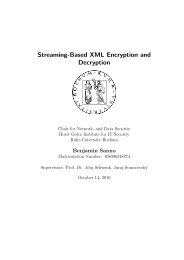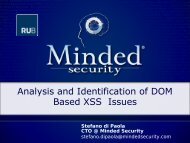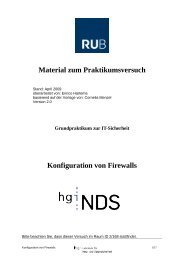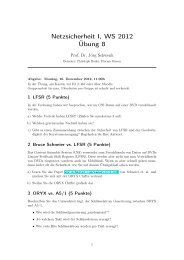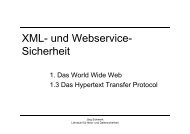One Bad Apple: Backwards Compatibility Attacks on State-of-the-Art ...
One Bad Apple: Backwards Compatibility Attacks on State-of-the-Art ...
One Bad Apple: Backwards Compatibility Attacks on State-of-the-Art ...
Create successful ePaper yourself
Turn your PDF publications into a flip-book with our unique Google optimized e-Paper software.
less obvious. Namely, that even if users have <strong>the</strong> best <strong>of</strong> intenti<strong>on</strong>s<br />
to use <strong>on</strong>ly <strong>the</strong> most up-to-date, vulnerability-free<br />
versi<strong>on</strong> <strong>of</strong> a system, <strong>the</strong> mere existence <strong>of</strong> support for old<br />
versi<strong>on</strong>s can have a catastrophic effect <strong>on</strong> security. We show<br />
this in <strong>the</strong> c<strong>on</strong>text <strong>of</strong> systems employing cryptography, introducing<br />
what we term backwards compatibility (BC) attacks.<br />
Like all good attacks, <strong>the</strong>se are obvious in retrospect,<br />
but <strong>the</strong>y do not seem to have been fully explored before.<br />
As we shall discuss in more detail below, <strong>the</strong>y are closely<br />
related to, but distinct from, versi<strong>on</strong> rollback attacks [72].<br />
As a taster <strong>of</strong> our attacks to follow, c<strong>on</strong>sider a situati<strong>on</strong><br />
where, for backwards compatibility reas<strong>on</strong>s, a system still<br />
allows <strong>the</strong> use <strong>of</strong> CBC mode encrypti<strong>on</strong>, but where Galois<br />
Counter Mode (GCM) is <strong>the</strong> preferred secure encrypti<strong>on</strong><br />
scheme. The reas<strong>on</strong> to switch to GCM may be that <strong>the</strong> CBC<br />
mode is vulnerable to <strong>on</strong>e <strong>of</strong> <strong>the</strong> several attacks that can,<br />
under certain circumstances, recover plaintext when it is encrypted<br />
in this mode – <strong>the</strong>se attacks exploit <strong>the</strong> malleability<br />
<strong>of</strong> CBC-mode (i.e., an attacker is able to make meaningful<br />
changes to an encrypted plaintext by making purposeful<br />
changes to <strong>the</strong> ciphertext) in combinati<strong>on</strong> with <strong>the</strong> availability<br />
<strong>of</strong> an “oracle” telling <strong>the</strong> attacker whe<strong>the</strong>r modified<br />
plaintexts are still valid. Such oracles can, for instance, be<br />
based <strong>on</strong> error messages returned due to invalid padding<br />
(“padding oracle attacks” [69, 24]) or o<strong>the</strong>r properties <strong>of</strong><br />
<strong>the</strong> plaintext, like malformed XML structure [39]. The detailed<br />
descripti<strong>on</strong> <strong>of</strong> <strong>the</strong>se oracles is bey<strong>on</strong>d <strong>the</strong> scope <strong>of</strong> this<br />
paper – for us it is <strong>on</strong>ly important to know that in certain<br />
scenarios an attacker is able to decrypt CBC-ciphertexts,<br />
due to a weakness <strong>of</strong> CBC. Now what happens if users select<br />
GCM as <strong>the</strong>ir preferred mode? Then an attacker who<br />
can modify messages so that <strong>the</strong>y are decrypted using CBC<br />
mode instead <strong>of</strong> GCM can use <strong>the</strong> old attack to decrypt <strong>the</strong><br />
ciphertexts as if <strong>the</strong>y were CBC encrypted. Here we assume<br />
that <strong>the</strong> same key is used, irrespective <strong>of</strong> <strong>the</strong> mode. Then,<br />
as we explain in detail in Secti<strong>on</strong> 2, this CBC decrypti<strong>on</strong><br />
capability can be quickly and efficiently turned into a distinguishing<br />
attack against GCM.<br />
This situati<strong>on</strong> not purely hypo<strong>the</strong>tical. As we will see,<br />
this is exactly <strong>the</strong> evoluti<strong>on</strong>ary path that has been followed<br />
in <strong>the</strong> XML Encrypti<strong>on</strong> standards. Very recently, <strong>the</strong> XML<br />
Encrypti<strong>on</strong> Working Group published a new XML Encrypti<strong>on</strong><br />
standard draft [27] to recommend <strong>the</strong> use <strong>of</strong> GCM in<br />
preference to CBC mode in resp<strong>on</strong>se to such an attack [39].<br />
CBC mode is retained in <strong>the</strong> standard for backwards compatibility<br />
reas<strong>on</strong>s. And <strong>the</strong> same key is used for both GCM<br />
and CBC mode. Finally, a man-in-<strong>the</strong>-middle attacker can<br />
easily manipulate XML document fields so that <strong>the</strong> use <strong>of</strong><br />
CBC mode for decrypti<strong>on</strong> is indicated instead <strong>of</strong> GCM. So<br />
all <strong>the</strong> pre-c<strong>on</strong>diti<strong>on</strong>s for our attack are met. Since CBC<br />
mode is mandatory, any state-<strong>of</strong>-<strong>the</strong>-art, standard-compliant<br />
implementati<strong>on</strong> <strong>of</strong> XML Encrypti<strong>on</strong> will be vulnerable to<br />
this BC attack, even if all h<strong>on</strong>est users exclusively stick to<br />
using GCM. We will dem<strong>on</strong>strate a practical distinguishing<br />
attack against an implementati<strong>on</strong> <strong>of</strong> XML Encrypti<strong>on</strong> using<br />
this attack vector in Secti<strong>on</strong> 5.<br />
This basic BC attack motivates <strong>the</strong> following questi<strong>on</strong>s,<br />
which we attempt to answer in this paper:<br />
• Which o<strong>the</strong>r encrypti<strong>on</strong> modes (and, more generally,<br />
cryptographic schemes), can interact with <strong>on</strong>e ano<strong>the</strong>r<br />
badly in this kind <strong>of</strong> scenario?<br />
• To what extent do deployed systems fall victim to this<br />
class <strong>of</strong> attack?<br />
• What countermeasures are readily available?<br />
The last questi<strong>on</strong> seems simplest to answer: use appropriate<br />
key separati<strong>on</strong> to ensure that <strong>the</strong> same keys are<br />
not used in “weak” and “str<strong>on</strong>g” cryptographic algorithms.<br />
However, this apparent simplicity is deceptive. Our experience<br />
is that developers sometimes fail to appreciate this requirement,<br />
or understand <strong>the</strong> requirement but fail to provide<br />
key separati<strong>on</strong> because <strong>the</strong>y do not want to even invest <strong>the</strong><br />
small development effort needed to implement suitable key<br />
derivati<strong>on</strong> algorithms. Moreover, in <strong>the</strong> c<strong>on</strong>text <strong>of</strong> public<br />
key cryptography, <strong>the</strong> most comm<strong>on</strong> data format for transporting<br />
public keys, <strong>the</strong> X.509 certificate, does not by default<br />
c<strong>on</strong>tain a field that limits <strong>the</strong> cryptographic algorithms<br />
in which a public key and its corresp<strong>on</strong>ding private key can<br />
be used. For example, a public key specified in an X.509<br />
certificate as being an RSA encrypti<strong>on</strong> key could be used in<br />
ei<strong>the</strong>r <strong>the</strong> PKCS#1 v1.5 or <strong>the</strong> PKCS#1 v2.1 (RSA-OAEP)<br />
encrypti<strong>on</strong> algorithms, with <strong>the</strong> former possibly being subject<br />
to Bleichenbacher-style [13] attacks. This lack <strong>of</strong> precisi<strong>on</strong><br />
opens up <strong>the</strong> possibility <strong>of</strong> BC attacks in <strong>the</strong> public<br />
key setting.<br />
For <strong>the</strong> first questi<strong>on</strong>, we do not attempt a systematic<br />
analysis <strong>of</strong> all <strong>the</strong> possibilities, since even <strong>the</strong> number <strong>of</strong><br />
basic modes <strong>of</strong> operati<strong>on</strong> <strong>of</strong> a block cipher precludes this.<br />
Instead, we examine some particularly attractive (from <strong>the</strong><br />
attacker’s point <strong>of</strong> view) cases in <strong>the</strong> symmetric and asymmetric<br />
settings. Specifically, we look at <strong>the</strong> interacti<strong>on</strong>s between<br />
CBC mode and GCM, this being particularly important<br />
in <strong>the</strong> c<strong>on</strong>text <strong>of</strong> XML Encrypti<strong>on</strong>, and between CBC<br />
mode and <strong>the</strong> AES Key Wrap algorithm. In both cases, we<br />
are able to mount a BC attack to break what should be a<br />
secure algorithm. In <strong>the</strong> public key setting, we focus <strong>on</strong><br />
RSA encrypti<strong>on</strong> and signatures, showing a BC attack <strong>on</strong><br />
RSA-OAEP when it is used in c<strong>on</strong>juncti<strong>on</strong> with an implementati<strong>on</strong><br />
<strong>of</strong> PKCS#1v1.5 encrypti<strong>on</strong> that is vulnerable to<br />
Bleichenbacher’s attack [13]. We also remark that a signature<br />
forgery attack is possible under <strong>the</strong> same circumstances;<br />
here we require <strong>the</strong> same RSA key to be allowed<br />
for use in both encrypti<strong>on</strong> and signature algorithms, a situati<strong>on</strong><br />
promoted for instance by [32, 61].<br />
To address <strong>the</strong> sec<strong>on</strong>d questi<strong>on</strong>, we dem<strong>on</strong>strate working<br />
BC attacks against <strong>the</strong> most recent drafts <strong>of</strong> <strong>the</strong> W3C<br />
XML Encrypti<strong>on</strong> [29] and XML Signature [30] standards,





